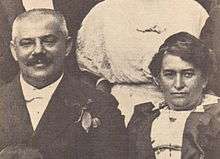Ottla Kafka

Ottilie "Ottla" Kafka (29 October 1892 – 1943) was the youngest sister of Franz Kafka. His favourite sister, she was probably also his closest relative and supported him in difficult times. Their correspondence was published as Letters to Ottla.
Life

Ottilie, called Ottla by her family, was born in Prague, then part of the Austro-Hungarian Empire, into a middle-class Ashkenazi Jewish family. Her father was the businessman Hermann Kafka (1852–1931), her mother, Julie (1856–1934), was the daughter of Jakob Löwy, a brewer in Poděbrady. She had three siblings, Franz, Gabriele ("Ellie") (1889–1944) and Valerie ("Valli") (1890–1944).[1] She was Franz's favourite sister.[2] She was a close confidant (enge Vertraute), and he called her unbeschadet der Liebe zu den anderen, die bei weitem liebste (the love to the others notwithstanding, the dearest by far).[3] He helped her get an education at an agricultural school. She lived and worked at the agricultural estate of her brother-in-law, Karl Hermann, in West Bohemian Zürau (now Siřem, community Blšany).[4] In 1916–17, she provided her brother with a writing refuge where he was able to write many short stories,[5] and he also lived on Hermann's estate from September 1917 to April 1918, already suffering from tuberculosis. During this time he wrote Die Zürauer Aphorismen (The Zürau Aphorisms).[4]
In July 1920, Ottla married the Czech Catholic Joseph David, against her father's will. Their daughters Věra and Helene were born in 1921 and 1923. Franz Kafka watched them grow up until he died in June 1924. The marriage was not happy and they were divorced in August 1942. Ottla thus lost her protection against the persecution of Jews.[4]
Like many other Jews from Prague, Ottla and her sisters were deported during World War II by the Nazis. Elli and Valli were sent with their families to the Łódź Ghetto, where they perished. Ottla was sent to the concentration camp at Theresienstadt. On 7 October 1943, Ottla accompanied a group of children as a voluntary assistant to Auschwitz concentration camp, where she was murdered a short time later.[3][6]
Legacy
The correspondence between Franz and Ottla Kafka is preserved. It was first published in 1974 by Hartmut Binder and Klaus Wagenbach, and published in English as Letters to Ottla & the Family. In January 2011 it was announced that the original letters were to be sold as a bundle at a Berlin auction house.[3] The German Literature Archive in Marbach hoped to be able to obtain it with help from the private sector;[7] in April 2011 they and the Bodleian Library in Oxford acquired it. They thanked Ottla's heirs for their willingness to sell before the auction, and those who assisted in making it possible to raise the needed funds, including one generous donor who remained anonymous at his own request.[8]
References
- ↑ Gilman, Sander (1995). Franz Kafka, the Jewish Patient. New York: Routledge. ISBN 978-0-415-91391-1.
- ↑ Gray, Richard T. (2005). A Franz Kafka Encyclopedia. Westport, CT: Greenwood Publishing Group. p. 53. ISBN 978-0-313-30375-3. Retrieved 10 August 2012.
- 1 2 3 Spiegel, Hubert (24 January 2011). "Die Frau, bei der Kafka ein anderer war". Frankfurter Allgemeine Zeitung (in German). Retrieved 10 August 2012.
- 1 2 3 Pawel, Ernst (1985). "Twenty-four". The Nightmare of Reason: A Life of Franz Kafka. New York: Vintage Books. ISBN 978-0-37452-335-0.
- ↑ Koelb, Clayton (2010). Kafka: A Guide for the Perplexed. London: Continuum. p. 49. ISBN 9780826495792.
- ↑ Czech, Danuta (1992). Kalendarz wydarzeń w KL Auschwitz (in Polish). Oświęcim: Wydawn. p. 534.
- ↑ "Alle für Ottla". Frankfurter Allgemeine Zeitung (in German). 3 February 2011.
- ↑ Exhibit list "Briefe an Ottla". by Franz Kafka and others. German Literature Archive in Marbach on the occasion of the exhibit 1 July to 10 September 2011 in the Modern Literature Museum, Marbach am Neckar.